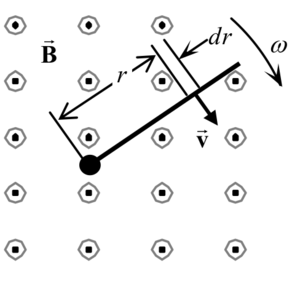Difference between revisions of "Chapter 29 Problem 73"
From 105/106 Lecture Notes by OBM
(Created page with "==Problem== 300px|center|Rotating metal rod A thin metal rod of length <math>l</math> rotates with angular velocity <math>\omega</math> about...") |
|||
| (One intermediate revision by the same user not shown) | |||
| Line 2: | Line 2: | ||
[[File:Chapter29Problem73q.png|300px|center|Rotating metal rod]] | [[File:Chapter29Problem73q.png|300px|center|Rotating metal rod]] | ||
A thin metal rod of length <math>l</math> rotates with angular velocity <math>\omega</math> about an axis through one end. The rotation axis is perpendicular to the rod and is parallel to a uniform magnetic field <math>\vec{B}</math> . Determine the emf developed between the ends of the rod | A thin metal rod of length <math>l</math> rotates with angular velocity <math>\omega</math> about an axis through one end. The rotation axis is perpendicular to the rod and is parallel to a uniform magnetic field <math>\vec{B}</math> . Determine the emf developed between the ends of the rod | ||
| + | |||
| + | ==Solution== | ||
| + | [[File:Chapter29Problem73s.png|300px|center|Rotation and flux]] | ||
| + | <math>d\mathcal{E}=Bvdr=B\omega r dr </math> | ||
| + | |||
| + | <math>\mathcal{E}=\int d\mathcal{E}=\int_0^{l}B\omega r dr=\frac{1}{2}B\omega l^2</math> | ||






